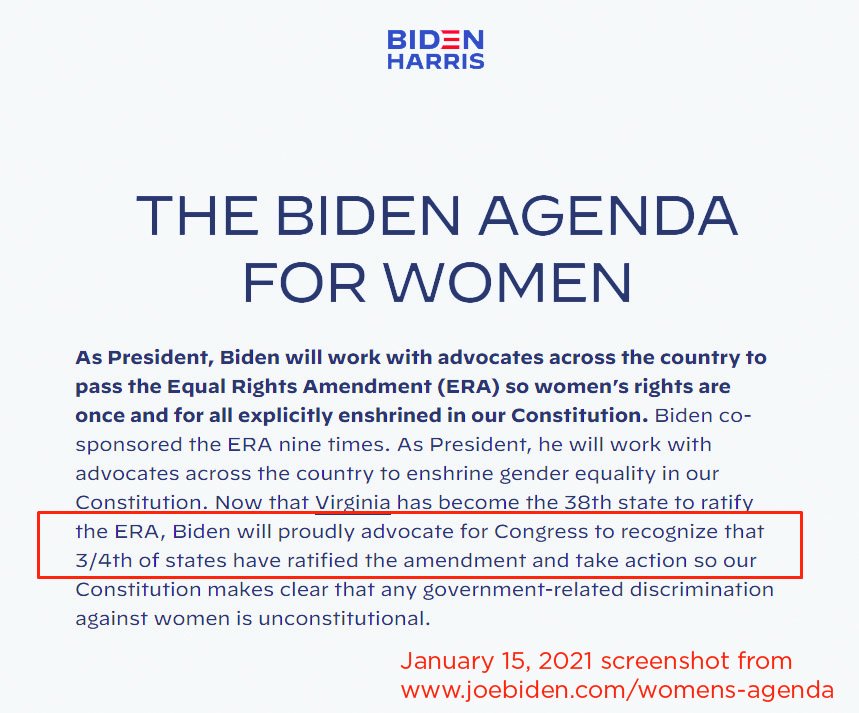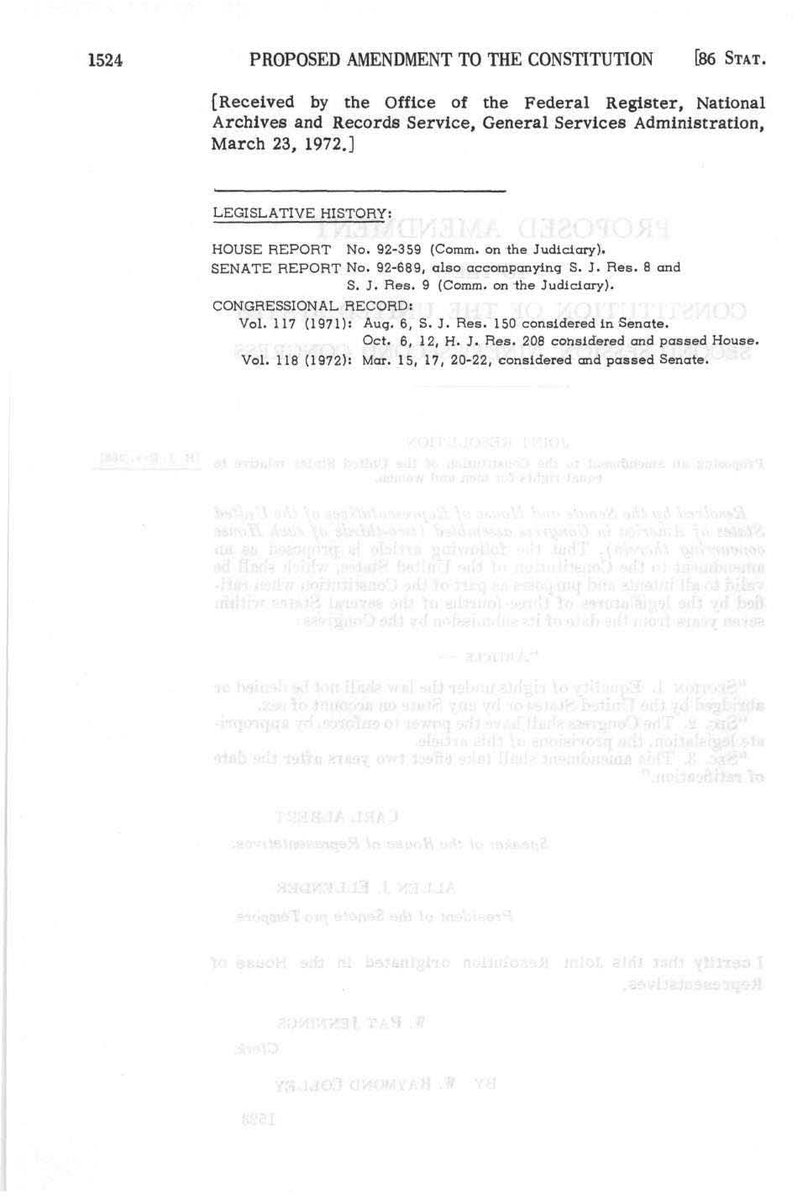
"The Equal Rights Amendment 2021" is a great show. There is a lot happening-- Congress, Executive Branch, federal courts, state legislatures, the media. But where is all this going? Much of what you now see is political theater. To understand this better, we must go back... 

ERAs have proposed in Congress since 1923. But for many decades, they were unable to surmount the high hurdles found in Article V of the Constitution. Article V succinctly spells out how the Constitution may be amended. To protect the text of the Constitution, 

the Framers required extraordinarily levels of political consensus to amend. Two methods were provided, but only one has been employed-- Congress, by 2/3 votes, proposes an amendment, but it only becomes part of the Constitution if 3/4 of state legislatures (now, 38) ratify it. 

Each congressional submission MUST contain a "Proposing Clause" (don't call it a "preamble"), which tells the states whether to consider ratification of the proposal in conventions (only used once), or in their legislatures. 

In a unanimous opinion in 1921 (Dillon v. Gloss), the U.S. Supreme Court said that Congress may, if it chooses, include a deadline in its submission. In a 1939 opinion, SCOTUS said such a deadline may appear either in the proposing resolution, or in text. 

Every constitutional amendment proposed by Congress since 1960 has included 7-year deadline in the Proposing Clause, including four that were ratified -- the 23rd, 24th, 25th, & 26th Amendments, as DOJ Office of Legal Counsel explained in Jan. 2020 legal opinion on the ERA. 





In 1970 (91st Congress), the House of Representatives approved the ERA. There was a big fight in the Senate, which adopted amendments unacceptable to sponsors, including a 7-year deadline. The ERA did not clear the Senate that year.
ERA sponsors reluctantly decided to keep the deadline provision, to diminish opposition. "Proponents eventually relented and inserted a seven-year time limit," noted Judge Contreras, Virginia v. Ferriero. In the next (92nd) Congress, they included the deadline from the start. 



With that compromise, the ERA Resolution (H.J. Res. 208) finally won the required 2/3 votes in the 92nd Congress-- first in the House in 1971, then the Senate on March 22, 1972. The seven-year clock began running.
There was an initial rush to ratify -- 30 states in the first year. Then things slowed down a lot, as opposition built and states debated possible or likely legal effects of ERA. Several legislatures passed resolutions to reverse ("rescind") their original ratifications.
By fall 1978, it was clear ERA would not have the required 38 states by the deadline -- March 22, 1979. In an unprecedented move, ERA advocates demanded that Congress extend the deadline, and by simple majority votes, not 2/3! 

Many scholars and lawmakers said it was unconstitutional -- even the Washington Post editorial board objected! 

But, the Carter Administration Justice Department gave qualified endorsement to the scheme--IF done before deadline expired. 

The measure (H.J. Res. 638) passed, purporting to "extend" the deadline for 39 months, to June 30 1982. The Constitution gives the President no role on constitutional amendments, but President Carter signed the resolution anyway. He wanted the photo op. 

Some state legislators in Idaho sued,and NOW got into the case. In 1981, federal District Judge Marion Callister (appointed by President Ford) ruled that the "deadline extension" was unconstitutional, and that the rescissions by Idaho & other states were valid. (Idaho v. Freeman) 



The WashPost said it was "the single most staggering defeat for ERA since it was placed before the states in 1972." The NY Times said Callister "has issued judgments enough to kill the ERA two or three times over," called for "Supreme Court correction...reversal has to be swift." 

The Supreme Court put Judge Callister's ruling on hold, and agreed to review it. But no new states ratified by June 30, 1982. Thus, all sides agreed that the ERA had failed to achieve ratification.
The Acting Solicitor General of the U.S. informed the U.S. Supreme Court hat the ERA had "failed of adoption" any way you cut it, so the legal issues were moot--there was nothing really that had to be decided. 

SCOTUS agreed, dismissing (over NOW's protest) the case as moot; no justice dissented. (In March, 2021, a federal judge appointed by President Obama, Rudolph Contreras, noted that this action implied that the Supreme Court recognized that the ERA could no longer be ratified.) 

Recognizing that the original ERA was dead, the Democratic U.S. House leadership in 1983 made a "start-over" ERA a top priority -- H.J. Res. 1. 

But by this time, there was strong pro-life opposition. ERA sponsors brushed aside an "abortion-neutralization" amendment proposed by National Right to Life, voting it down in committee. 

The Dem leadership confidently took ERA to the House floor under a no-amendment procedure. To their stunned amazement, it went down to defeat, with 14 co-sponsors voting against it. (Nov. 15, 1983) 

The level of support for ERA in the House had sharply diminished between 1972 and 1983, with the ERA-abortion link being the single biggest factor. The ERA no longer commanded two-thirds support even in the Democrat-controlled House. 

Keep in mind: as of mid-1982, all agreed the 1972 ERA was dead, and that starting over was the only option. Here, Gloria Steinem succinctly explained it, on Oprah in 1986.
#equalrightsamendment
#equalrightsamendment
But in 1993, some ERA supporters cooked up the so-called "3-state" theory. The basic notion: a deadline in a proposing clause is unconstitutional, or Congress can retroactively change such deadlines, forever. 



ERA supporters began to try to get the 15 states never-ratified states to "ratify." For 23 years, all such efforts failed. 

Finally, in 2017, the Nevada legislature adopted such a resolution, claiming to be the 36th ratifying state, followed by Illinois (2017). By late 2019, ERA proponents and the media were proclaiming that Virginia would soon be the "38th" ratifying state. 





In Sept. 2019, Justice Ruth Bader Ginsburg, a strong ERA backer, sent a cautionary signal: "I was a proponent of the Equal Rights Amendment. I hope someday it will be put back in the political hopper and we’ll be starting over again, collecting the necessary states to ratify it." 

On Jan. 6, 2020, the Office of Legal Counsel (OLC) of the Dept. of Justice issued an opinion asserting that the 1972 ERA had died March 22, 1979, and Congress lacked power to revive it retroactively. 



The Virginia legislature purported to ratify the ERA effective Jan. 27, 2020, but based on the OLC opinion, the Archivist of the U.S. had already said that he would not certify the ERA unless so ordered by a court. 

The AGs of VA, IL, NV sued the Archivist, claiming the deadline was unconstitutional. The case was assigned to federal Judge Contreras, a respected judge appointed by President Obama. 2 non-ratifying states (AL, LA) and 3 that rescinded (TN, NE, SD) joined as "intervenors." 

On Feb. 10, 2020, Justice Ginsburg was asked about ERA again: "I'd like it to start over. There's too much controversy about latecomers--Virginia, long after the deadline passed. Plus, a number of states have withdrawn their ratification...how can you disregard [them]...?" 

Justice Ginsburg's answer clearly signaled that the deadline and rescissions dictated that ERA supporters should "start over." But her implicit warning went unheeded.
On Feb. 13, 2020, the U.S. House of Representatives passed, on a vote nearly party line, a so-called "deadline removal" measure (H.J. Res. 79). The Senate did not act on it. 

In November 2020, Joe Biden was elected president. His campaign position was that Virginia had been the 38th ratifying state. The new Vice President, Kamala Harris, had sponsored "deadline removal" as a senator. 



In the new 117th Congress, "deadline removal" was reintroduced as (H.J. Res. 17, S.J. Res. 1)--without anyone noticing it was drafted to require 2/3 votes, as Article V requires. This "error" had to be quietly "fixed" before the House could pass the measure by a bare majority. 







On March 7, 2021, Judge Contreras (Obama appointee) ruled in Virginia v. Ferriero: "Congress set deadlines for ratifying the ERA that expired long ago. Plaintiffs' ratifications came too late to count." It would be "absurd" for Archivist to certify ERA.
nbcnews.com/politics/polit…
nbcnews.com/politics/polit…
Judge Contreras also made it pretty clear that the federal courts will have the last word on the 1972 ERA. 

So, the ERA-is-alive theory has collapsed under the scrutiny of two judges of widely different political backgrounds, 40 years apart (and was been turned aside on standing grounds by a third). Also, 17 Supreme Court justices have declined to vote for chances to review ERA cases.
In Feb. 2021, in replies to five Judiciary Committee senators, Attorney General nominee Merrick Garland said that "any opinions or legal advice I might give on this subject [ERA] would be based solely on the law, and not on any other consideration." 

Here is the "ERA map" as of March, 2021. In the view of many, it shows the results of a bona fide 7-year ratification period, followed by more than 40 years of pro-ERA activists creating and chasing political constructs not based in sound constitutional law. 

Here is the official list of state ERA-related actions as maintained by the National Archives and Records Administration (March 24, 2020) 

There is only one constitutional path for those who want an Equal Rights Amendment in the Constitution, and it is the one Justice Ginsburg repeatedly urged: "Start over." 

Yes, there are hurdles. Here is one: Prominent abortion-rights groups now openly proclaim the ERA would invalidate "hundreds" of pro-life laws. Many of the ratifying states of 1972-1979 are not on board for that.
More on that issue in this thread:
More on that issue in this thread:
https://twitter.com/ERANoShortcuts/status/1368723341331337216?s=20
• • •
Missing some Tweet in this thread? You can try to
force a refresh

























